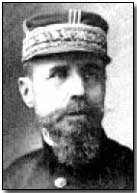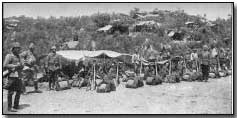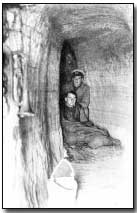Battles - The Third Battle of Krithia, 1915
 With only modest progress
accompanying the Allied attack at the
Second Battle of
Krithia in the first week of May 1915, regional Commander-in-Chief
Sir Ian Hamilton
urged his local commander
Aylmer
Hunter-Weston at Helles to maintain a policy of "ceaseless initiative"
against the Turkish lines stretched some 7km across the southern tip of the
peninsular.
With only modest progress
accompanying the Allied attack at the
Second Battle of
Krithia in the first week of May 1915, regional Commander-in-Chief
Sir Ian Hamilton
urged his local commander
Aylmer
Hunter-Weston at Helles to maintain a policy of "ceaseless initiative"
against the Turkish lines stretched some 7km across the southern tip of the
peninsular.
Hamilton remained as determined as he had been at the start of the campaign to seize control of the prominent hill feature of Achi Baba, some 2km to the rear of the village of Krithia. Ever since the landings of 25 April 1915 Hunter-Weston had suffered from penetrating fire poured down from the Turkish forces occupying Achi Baba.
Hunter-Weston himself still believed that both Krithia and Achi Baba could be occupied with the aid of further reinforcements. Such was Hunter-Weston's boundless (and largely ill-founded) confidence that his opinions carried greater than usual weight with both Hamilton and his staff at General Headquarters.
Thus Hunter-Weston, in preparation for a third assault against Krithia in early June, launched a series of four modest night advances on 18, 23, 24 and 27 May. These resulted in the Allied line moving forward some three-quarters of a kilometre with little loss - as few as 50 casualties; the single kilometre gained during the Second Battle of Krithia had in contrast cost some 6,000 casualties.
 For
the most part however the period between the Second and Third Battles
comprised a period of particularly unpleasant trench warfare for the
combined British and French force sited at Helles. Protection against
the murderous hail of shells and machine gun fire was far more problematic
at Helles than in many areas of the Western Front.
For
the most part however the period between the Second and Third Battles
comprised a period of particularly unpleasant trench warfare for the
combined British and French force sited at Helles. Protection against
the murderous hail of shells and machine gun fire was far more problematic
at Helles than in many areas of the Western Front.
Aside from holding the upper hand in the matter of trench warfare the Turk defenders were further buoyed by their success in sinking two British battleships - Triumph on 25 May and Majestic three days later - via torpedo, reducing the effectiveness of the Allies' offshore naval presence, an important factor in supporting land operations.
On 24 May the British divisions sited at Helles were grouped together as VIII Corps and Hunter-Weston - already effectively the local commander - placed at its head. Hamilton, ahead of the opening of the next phase of the battle, issued instructions strictly limiting aims to given objectives. He had abandoned the notion of securing the prized Achi Baba feature in a single day, preferring instead to seize the enemy's forward trench lines and use these as the basis for further attacks.
Battle was duly renewed at noon on a sunny, breezy 4 June and was the result of a joint initiative between Hunter-Weston and the newly-arrived (15 May) French commander Henri Gouraud. Gouraud's working relationship with the British was notably stronger than the predecessor he replaced, General d'Amade. During the course of his service at Gallipoli the recklessly courageous Gouraud was to break both legs and lose an arm (moving King George V to send a telegram of consolation to Hamilton).
 Preceded
as usual by an ineffective
shrapnel bombardment from eighteen-pounder
artillery the Allied attack made early gains, particularly from the 42nd
(East Lancashire) Division to the British right. The French - to the
extreme right - struggled in particular.
Preceded
as usual by an ineffective
shrapnel bombardment from eighteen-pounder
artillery the Allied attack made early gains, particularly from the 42nd
(East Lancashire) Division to the British right. The French - to the
extreme right - struggled in particular.
The attack was launched in two waves: the first intended to capture the Turkish front line with the second promptly leap-frogging them. Within 90 minutes of the attack's commencement the only effective progress had been made by 42nd Division in the centre: the Allied flank attacks had been repelled.
At this stage Hunter-Weston and Gouraud agreed to commit reserve battalions to re-attempt the flank attacks rather than to exploit the 42nd Division's success in pushing to within a kilometre of Krithia village.
Nevertheless the overall attack was once again largely thrown back by a determined Turkish defence commanded by attached German officer Liman von Sanders. Allied gains were minimal and - as usual - at significant cost: some 6,500 additional casualties (4,500 British, 2,000 French). Turkish losses were estimated at between 9,000-10,000.
Nevertheless it was subsequently argued by some (in both British and German camps) that had the British been able to remount the attack on the following day - which wasn't in any event possible - a breakthrough would have been probable given the perilously weakened and fatigued state of Liman's Turkish defence.
Over the following two days, 5 and 6 June, the Turks nevertheless mounted heavy counter-attacks intended once more at driving the Allied force back into the sea. Hunter-Weston found himself handicapped in dealing with the Turkish assault given that many of his reserve battalions had already been used in supporting failed operations on 4 June.
Nevertheless the Allied force eventually managed to repel the Turkish advance, Hunter-Weston observing that the manner in which his Territorial force held their positions was even more impressive than their capture of the same on 4 June.
The British war minister in London, Lord Kitchener, was shocked upon receiving news from Hamilton of the extent of casualties incurred during the latest attack. He consequently gave Hamilton assurances of far larger reinforcements.
In the meantime Hamilton effectively abandoned operations at Helles and turned his attention further north, to Anzac Cove.
To view maps detailing the progress of the Gallipoli campaign click here; and here; and here; and here.
Photographs courtesy of Photos of the Great War website
"Harry Tate" was the nickname given by British pilots to the R.E.8 aircraft
- Did you know?
